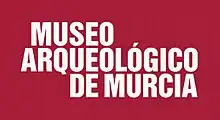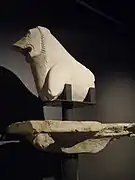Archaeological Museum of Murcia
The Archaeological Museum of Murcia (Spanish: Museo Arqueológico de Murcia; MAM) stands as a testament to the rich historical and cultural heritage of the region of Murcia, Spain. Situated in the heart of the region, this State-owned landmark holds a diverse collection of artifacts, and exhibits that provide an immersive journey through the fascinating history of the area.
Museo Arqueológico de Murcia | |
 | |
.jpg.webp) Museum's facade | |
| Established | 1864 |
|---|---|
| Location | Murcia, Spain |
| Coordinates | 37°59′23″N 1°07′50″W |
| Type | Archaeological museum |
| Owner | General State Administration |
First established in the late 19th century, the museum was designed to reflect the Spanish government's commitment to preserving and showcasing the archaeological wealth of the Murcia region. Since its inception, the museum has evolved and expanded significantly, both in terms of its collection and the facilities it offers to visitors. Today, it stands as a premier institution for archaeological research, education, and public engagement.
The museum's collection spans thousands of years, from prehistoric times to the modern era. Its exhibits encompass a wide array of archaeological finds, including ancient artifacts, ceramics, sculptures, jewelry, and more. Through these artifacts, visitors can explore the ancient civilizations that once thrived in this region, such as the Iberians, Romans, and Moors.
History
The Museum of Antiquities of Murcia was created by means of a 6 July 1864 royal order, constituted as an added section to the Museum of Painting and Sculpture (created earlier in the year).[1] In 1910, the museum moved to the Cerdán building,[2] moving again in the 1950s to its current premises, the Casa de la Cultura.[3] The Spanish State transferred the museum's management to the Murcia's regional administration in 1984, while retaining its ownership.[1]
 Lion of Coy (2nd half of the 1st millennium BC)[4]
Lion of Coy (2nd half of the 1st millennium BC)[4]![Ionic capital found in the Roman vila of Huerta del Paturro (Portmán [es], La Unión)](../I/Capitel_paturro.JPG.webp)

References
- Citations
- Gómez Ródenas 2017, p. 1828.
- Gómez Ródenas 2017, pp. 1831–1833.
- Gómez Ródenas 2017, pp. 1837–1839.
- Urrea Méndez & Costa González 2018, pp. 72–76.
- Ramallo Asensio 2011–2012, p. 626.
- Noguera Celdrán 1989, pp. 155–157.
- Bibliography
- Gómez Ródenas, María Ángeles (2017). "El Museo Arqueológico de Murcia. 150 años de historia" (PDF). Boletín del Museo Arqueológico Nacional. Madrid: Museo Arqueológico Nacional. 2017: 1827–1845. ISSN 2341-3409.
- Noguera Celdrán, José Miguel (1989). "Una cabeza de Sátiro de la villa romana de la Huerta del Paturro (Portmán-Murcia)". Anales de Prehistoria y Arqueología. Murcia: Servicio de Publicaciones, Universidad de Murcia: 155–160. ISSN 0213-5663.
- Ramallo Asensio, Sebastián F. (2011–2012). "Capiteles jónicos de aire corintizante en Cartagena". Cuadernos de Prehistoria y Arqueología de la Universidad Autónoma de Madrid. Madrid: UAM Ediciones. 37–38. doi:10.15366/cupauam2012.38.033. hdl:10486/12471.
- Urrea Méndez, Josefa; Costa González, Daniel (2018). "No es tan fiero como lo pintan. La presencia del león en la literatura y en la arqueología: De los larnakes griegos y macedonios al león ibérico de Coy (Lorca)" (PDF). Alberca. 16: 71–95. ISSN 1697-2708.